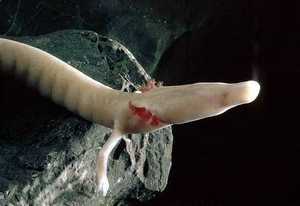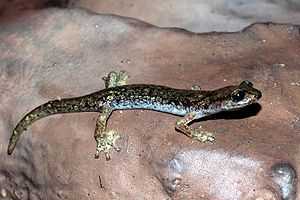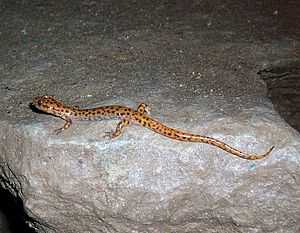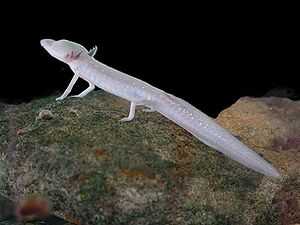Cave salamander

Several salamanders that primarily or exclusively inhabit caves have commonly been termed “cave salamanders”. Some of these animals have developed special, even extreme, adaptations to their subterranean environments. These adaptations include rudimentary (or even absent) eyes — thus the related term "blind salamanders" — or absence of pigmentation, rendering them a pale yellowish or pinkish color (e.g., Proteus anguinus, Eurycea rathbuni). With one highly notable exception, all "cave salamanders" are members of the family Plethodontidae ("lungless salamanders").
History
The first intense and continuous scientific study of a cave animal was focused on a cave salamander, Proteus anguinus. It was originally identified as a "dragon's larva" by Janez Vajkard Valvasor in 1689. Later, the Austrian naturalist Joseph Nicolaus Lorenz described it scientifically in 1768.[1]
Another early scientific description of a cave salamander was undertaken by Constantine Samuel Rafinesque in 1822 while he was a professor of botany and natural history at Transylvania University in Lexington, Kentucky. The species he described was known to the locals as a "cave puppet" and is now known to be Eurycea lucifuga. His discovery was not surprising at the time because E. lucifuga inhabits near the entrance of caves, thus an in-depth exploration was not required; and, E. lucifuga is neither blind nor depigmented.[1]
List of cave salamanders



- The following species have commonly been termed “the cave salamander” without any additional modifier or adjective:
- The olm (Proteus anguinus), or proteus, a unique blind salamander endemic to caves of southeastern Europe
- The spotted-tail cave salamander (Eurycea lucifuga), a lungless salamander endemic to caves of the eastern United States
- Eurycea (of North America) and Speleomantes (of Italy and France) are two genera of lungless salamanders with so many individual species termed “cave salamanders” that the entire group is sometimes so designated.
- Individual species of “cave salamander” (in some cases "blind salamander"), usually designated with an additional modifier or adjective in their common name, include the following lungless salamanders:
- Eurycea rathbuni, the Texas cave salamander, or Texas blind salamander (formerly, Typhlomolge rathbuni)
- Eurycea tridentifera, the Honey Creek Cave Blind Salamander, or Comal Blind Salamander
- Eurycea spelaea, the Ozark Blind Salamander, or Grotto Salamander (formerly, Typhlotriton speleus)
- Speleomantes ambrosii, Ambrosi's Cave Salamander, or French Cave Salamander, or Spezia Cave Salamander
- Speleomantes imperialis, Imperial Cave Salamander, or Scented Cave Salamander
- Speleomantes supramontis, the Supramonte Cave Salamander
- Speleomantes italicus, the Italian cave salamander
- Speleomantes flavus, the Monte Albo Cave Salamander, or Stefani's Salamander
- Speleomantes strinatii, Strinati's cave salamander
- Speleomantes sarrabusensis, Sarrabus' cave salamander
- Gyrinophilus palleucus, the Tennessee Cave Salamander
- G. p. necturoides, the Big Mouth Cave salamander
- Gyrinophilus gulolineatus, the Berry cave salamander
- Atylodes genei, the brown cave salamander, or Gene's cave salamander, Sardinian cave salamander, or simply Sardinian salamander
- Chiropterotriton mosaueri, the Cave Splayfoot Salamander
- Haideotriton wallacei, the Georgia blind salamander (Haideotriton is considered synonymous with Eurycea by some experts.)